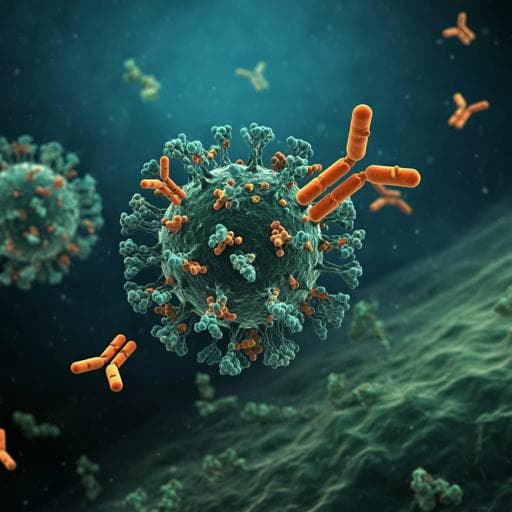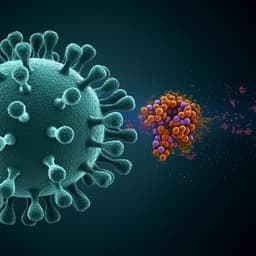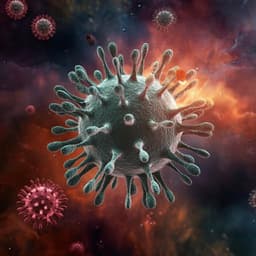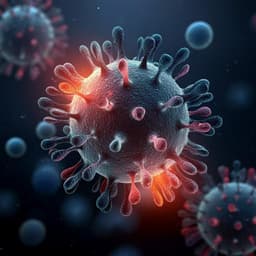
Medicine and Health
Shark nanobodies with potent SARS-CoV-2 neutralizing activity and broad sarbecovirus reactivity
W. Chen, A. Hajduczki, et al.
Discover how nurse sharks, through innovative immunization, produced powerful antibodies that neutralized SARS-CoV-2 variants, including Omicron! This groundbreaking research conducted by a team of experts from the Walter Reed Army Institute of Research and the University of Maryland holds promise for developing new immunotherapeutics.
~3 min • Beginner • English
Introduction
SARS-CoV-2, a betacoronavirus causing COVID-19, remains a major global health threat due to continual zoonotic emergence and evolution of variants of concern (VoC) with increased transmissibility and immune escape. Although effective vaccines exist, there is an urgent need for next-generation prophylactics, therapeutics, and diagnostics with broad activity against diverse sarbecoviruses. Cartilaginous fishes (sharks) produce heavy-chain antibodies (IgNAR) whose variable domains (VNARs) are the smallest natural nanobodies and can generate diverse paratopes via unique CDR3 recombination and hypervariable regions (HV2, HV4). This study aimed to elicit anti-sarbecovirus VNARs by immunizing nurse sharks with SARS-CoV-2 RBD, RBD-ferritin (RFN), or spike-ferritin nanoparticles (SpFN), isolate and characterize VNAR-Fc chimeras (ShAbs), define their epitopes and structures, and engineer multi-specific formats to enhance breadth and potency against SARS-CoV-2 VoC and other sarbecoviruses.
Literature Review
The authors reference extensive prior work identifying neutralizing monoclonal antibodies (mAbs) and nanobodies against SARS-CoV-2 and classify RBD-targeting antibodies into epitope classes (e.g., Class III and IV). ShAb01 maps to a Class IV-like epitope reminiscent of CR3022, with broader and deeper contact than several camelid nanobodies (e.g., WNB10, NB30, VHH V, 3B4). ShAb02 targets a Class III-like face similar to S309 and REGN10987 but exhibits a unique VNAR epitope among reported nanobodies. The study situates its findings relative to VNARs from synthetic libraries (e.g., 3B4 and 2C02) and discusses epitope conservation across sarbecoviruses, emphasizing the need for broadly reactive antibodies due to Omicron-driven escape from many authorized mAbs.
Methodology
Immunogens: Designed SARS-CoV-2 Wuhan-Hu-1 sequence-based immunogens: RBD, RBD-ferritin (RFN), and spike-ferritin nanoparticles (SpFN). Structural modeling used PDB entries for spike and ferritin to optimize designs.
Shark immunizations: Six juvenile nurse sharks (2–3 years; 1.8–3.8 kg) were immunized under approved animal protocols. Groups: two with RBD (weeks 0, 4, 8, 13), two with RFN (weeks 0, 4, 8, 36), two with SpFN (weeks 0, 4, 8). Priming with CFA (200–250 μg), first boost with IFA (200–250 μg), subsequent 100 μg i.v. unadjuvanted boosts. Plasma IgNAR responses were monitored by ELISA against RBD and S-2P.
VNAR library construction and selection: Peripheral blood lymphocytes were collected after peak titers. Oligo-dT cDNA served as template to amplify VNARs, cloned into pHEN2 phagemid (library sizes >10^10). Phage display panning on RBD, SpFN, or RFN in immunotubes across rounds, with phage ELISAs to identify binders; inserts were sequenced.
Expression and purification: Selected VNARs were subcloned upstream of human IgG1 Fc to generate VNAR-Fc chimeras (ShAbs) and expressed transiently in Expi293F cells (yields 26–542 mg/L), purified by Protein A. Additional constructs for crystallography included protease/HIS tags. Trimeric VNARs were made via Foldon fusions. Bispecifics: (i) ShAb01H02K using Fc knob (T366Y) and hole (Y407T) mutations for heterodimerization; (ii) BiShAb0201 with ShAb02 linked to ShAb01 via a flexible (GGGGS)5/25-aa linker in sequential VNAR-Fc order.
Biophysical assays: ELISA assessed binding to RBD and S-2P. Biolayer interferometry (Octet RED96) measured kinetics (1:1 model) for WA-1 and VoC RBDs, and ACE2 competition on immobilized RBD or S-2P. Alanine-scanning mutagenesis mapped critical epitope residues.
Structural biology: The ternary complex of WA-1 RBD with ShAb01 and ShAb02 VNARs was crystallized (2.5 Å resolution). Data collection at APS 24-ID-E; structure solved by molecular replacement (Phaser) and refined (Phenix; Coot for model building).
Neutralization assays: Pseudoviruses (HIV-1 backbone) bearing SARS-CoV-2 spikes (WA-1, Alpha, Beta, Delta, Omicron BA.1/BA.5) or SARS-CoV-1 (Urbani) were produced. Neutralization measured in ACE2-expressing HEK293 cells; IC50 values determined by nonlinear regression. VSV-G pseudovirus served as control.
In vivo protection: K18-hACE2 transgenic mice (n=13/group; 200 μg ShAb01, ShAb02, or IgG1 isotype i.p.) were challenged 24 h later with 1.25×10^4 PFU SARS-CoV-2 WA-1 intranasally. Monitored for 14 days for weight, clinical score, survival; a subset (n=5/group) assessed for BAL viral load by plaque assay at day 2.
Effector function assays: Antibody-dependent cellular phagocytosis (ADCP) using S-2P bead-labeled antigens (SARS-CoV-2 WA-1; SARS-CoV-1 Urbani) incubated with phagocytes; NK cell degranulation (CD107a capture) with immobilized S-2P and NK cells.
Breadth analyses: BLI binding to a panel of 12 sarbecovirus RBDs (clades 1a, 1b, 2, 3) and ACE2-blocking measured; epitope conservation analyzed via sequence alignments and mapping onto RBD structures.
Key Findings
- Two distinct epitope-targeting VNAR-Fc chimeras (ShAb01 and ShAb02) were identified from immunized nurse sharks. Epitope binning showed two non-overlapping antigenic groups; ShAb01 group strongly blocked ACE2.
- Binding affinities: Both ShAb01 and ShAb02 bound SARS-CoV-2 RBD and S-2P with low-nanomolar KDs. For WA-1 and VoC Alpha/Beta/Gamma/Delta, KDs were 14.9–85.7 nM. ShAb02 maintained high affinity to Omicron BA.1/BA.2/BA.2.12.1 (∼50–125 nM), whereas ShAb01 affinity was reduced to Omicron subvariants. ShAb01 cross-reacted with SARS-CoV-1 RBD and bat sarbecoviruses.
- Neutralization: ShAb01 potently neutralized SARS-CoV-2 WA-1, Alpha, Beta, Delta, and SARS-CoV-1 (IC50 188–873 ng/mL). ShAb02 potently neutralized WA-1, Alpha, Beta, Delta (IC50 15–52 ng/mL) but was weaker vs SARS-CoV-1 (IC50 11.6 μg/mL). Against Omicron BA.1, ShAb01 showed minimal activity; ShAb02 retained neutralization (IC50 178 ng/mL) and neutralized BA.4/5 (IC50 ~1 μg/mL).
- In vivo efficacy: In K18-hACE2 mice challenged with WA-1, passive transfer (10 mg/kg) conferred protection. Survival: ShAb01 86%, ShAb02 43%, isotype 0% (all by day 8). ShAb01 delayed illness onset, reduced weight loss and clinical scores, and yielded undetectable BAL viral load at day 2; ShAb02 reduced BAL viral load ~10-fold vs control.
- Structural insights: Crystal structure (2.5 Å) of RBD–ShAb01–ShAb02 revealed sandwich-like binding on opposing RBD faces. Critical residues: Y369 for ShAb01; R346, N354, K356 for ShAb02. Both epitopes minimally overlap ACE2 footprint. Omicron BA.1 mutations (S371L, S373P, S375F) alter the Y369 region and clash with ShAb01 CDR3, explaining reduced binding.
- Engineered multi-specifics: Bispecifics (ShAb01H02K knob-in-hole Fc; BiShAb0201 tandem VNAR-Fc) showed >10-fold (vs ShAb01) and >3-fold (vs ShAb02) higher affinity across VoCs. For Delta RBD, affinity increases were extraordinary (ShAb01H02K ~389,000-fold; BiShAb0201 ~149,000-fold) due to markedly slower off-rates. Combining VNARs rescued Omicron BA.1 binding for ShAb01. Bispecifics increased affinity 1.6–1.9× to SARS-CoV-1 RBD over ShAb01 despite ShAb02 alone not binding SARS-CoV-1.
- Functional activity: Bispecifics and monospecific ShAbs blocked ACE2 in BLI assays using RBD or S-2P. ADCP: strong activity against SARS-CoV-2 S-2P for all ShAbs; ShAb01 and bispecifics showed strong ADCP against SARS-CoV-1, ShAb02 did not. NK degranulation: robust against SARS-CoV-2 S for all; against SARS-CoV-1 S, ShAb01 ~10% comparable to CR3022 (11.5%), bispecifics ~6%, ShAb02 none.
- Breadth: ShAb01 epitope is conserved across clades 1a/1b, with specific differences (e.g., K378 variants N/Q in clade 2/3) limiting binding to some strains. ShAb02 epitope is conserved across SARS-CoV-2 VoC (including Omicron), but varies substantially in other sarbecoviruses (e.g., R346T in RaTG13), enabling potential escape. BLI across 12 RBDs showed ShAb01 bound strongly to 7, intermediate to 3, and none to 2 (those with N/Q378). ShAb02 bound mainly to BANAL-20-247 (clade 1b). Bispecifics mirrored ShAb01 breadth with higher overall binding; both ShAb01H02K and BiShAb0201 showed robust ACE2 blocking for clade 1a/1b RBDs.
Discussion
This study demonstrates that immunization of nurse sharks with SARS-CoV-2-derived immunogens elicits VNARs targeting two conserved, non-overlapping RBD epitopes corresponding to Class IV- and Class III-like regions with minimal ACE2 overlap. These epitopes confer broad reactivity across VoCs, including Omicron, and extend to SARS-CoV-1 for ShAb01. Structural elucidation clarifies binding determinants and explains Omicron BA.1 escape from ShAb01 due to local conformational changes around Y369. Engineering bispecific VNAR-Fc constructs that combine the two epitopes greatly enhanced binding avidity/affinity, preserved ACE2 blockade, improved functional effector activities, rescued Omicron BA.1 binding for ShAb01, and extended breadth to SARS-CoV-1 despite ShAb02’s narrow cross-clade binding. In vivo, a single 10 mg/kg dose conferred significant protection in a stringent lethal K18-hACE2 challenge, particularly for ShAb01, underscoring potential therapeutic value. The Fc-fused and multivalent VNAR formats provide flexibility for therapeutic development, combining small size, stability, and Fc-mediated effector functions. Given continued VoC evolution and loss of efficacy of many authorized mAbs, these shark-derived nanobodies and multi-specific derivatives offer a promising avenue for durable, broad anti-sarbecovirus interventions.
Conclusion
The authors elicited and isolated shark VNARs (ShAb01, ShAb02) that bind two conserved, non-overlapping RBD epitopes, neutralize multiple SARS-CoV-2 VoCs and SARS-CoV-1, and protect K18-hACE2 mice from lethal challenge. Structural analysis enabled rational design of multi-specific VNAR-Fc constructs with dramatically enhanced affinity, sustained ACE2 blockade, robust effector functions, and broadened sarbecovirus reactivity. These results establish shark VNARs as potent, versatile candidates for antiviral therapeutics and inform structure-guided engineering for pandemic preparedness. Future work should assess aerosolizable VNAR formats, optimize Fc engineering for half-life/effector function, evaluate efficacy against live viruses and emerging VoCs, and test breadth and protection in additional animal models and in clinical studies.
Limitations
- Epitope-specific vulnerabilities: ShAb01 binding is reduced by Omicron BA.1 mutations (S371L, S373P, S375F) affecting the Y369 region; ShAb02 recognition depends on R346, N354, K356, residues that vary among non-clade 1b sarbecoviruses (e.g., R346T), enabling potential escape.
- Breadth constraints: ShAb01 shows limited binding to some clade 2/3 RBDs (e.g., N/Q378 variants), and ShAb02 binds poorly outside SARS-CoV-2-like clade 1b.
- In vivo scope: Protection was demonstrated only against SARS-CoV-2 WA-1 in K18-hACE2 mice at a single dose and timepoint; efficacy across other VoCs and dosing regimens requires further validation.
- Neutralization assays used pseudoviruses for breadth testing; confirmation with authentic viruses across variants and sarbecoviruses is needed.
- Multi-specific constructs were characterized biochemically and in vitro; comprehensive in vivo efficacy and pharmacokinetic/half-life studies remain to be performed.
Related Publications
Explore these studies to deepen your understanding of the subject.







